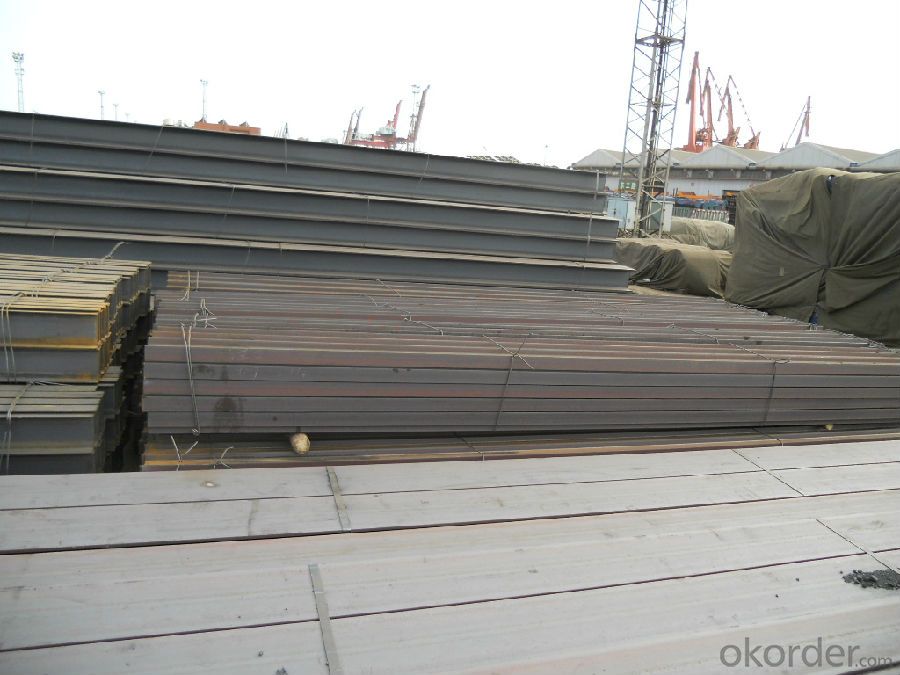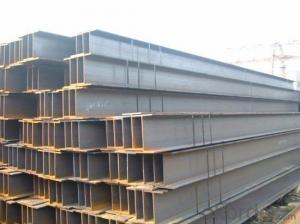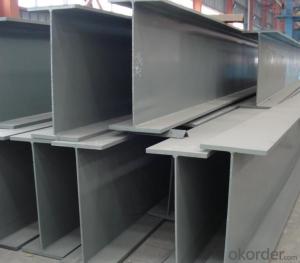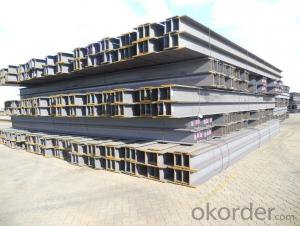Hot Rolled H Section Beam
- Loading Port:
- China Main Port
- Payment Terms:
- TT or LC
- Min Order Qty:
- 100 m.t.
- Supply Capability:
- 10000 m.t./month
OKorder Service Pledge
OKorder Financial Service
You Might Also Like
Product Description:
OKorder is offering Hot Rolled H Section Beam at great prices with worldwide shipping. Our supplier is a world-class manufacturer of steel, with our products utilized the world over. OKorder annually supplies products to African, South American and Asian markets. We provide quotations within 24 hours of receiving an inquiry and guarantee competitive prices.
Product Applications:
Hot Rolled H Section Beam are ideal for structural applications and are widely used inindustrial plants, civil construction, municipal works, oil platforms, bridges, flatbed beams, electrified railway power stand, railway bridges and other light steel structure, super-light H-beam is ideal for containers, mobile homes , all kinds of garage, box-type trains, electrical bracket, various venues, small villa manufacturing etc.
Product Advantages:
OKorder's Hot Rolled H Section Beam are durable, strong, and wide variety of sizes.
Main Product Features:
· Premium quality
· Prompt delivery & seaworthy packing (30 days after receiving deposit)
· Can be recycled and reused
· Mill test certification
· Professional Service
· Competitive pricing
Product Specifications:
Manufacture: Hot rolled
Grade: SS400, Q235,A36,S235JR
Standard: JIS G3101, GB STANDARD
Certificates: ISO, SGS, BV, CIQ
Length: 12m, as per customer request
Packaging: Export packing, nude packing, bundled
H Type Steel Size and Theoretical Weight | |||||
Size | Theoretical Weight | Size(mm) | Theoretical Weight | Size(mm) | Theoretical Weight |
(mm) | (kg/m) | (kg/m) | (kg/m) | ||
100*50*5*7 | 9.3 | 250*125*6*9 | 29 | 446*199*8*12 | 65.1 |
100*100*6*8 | 16.9 | 250*250*9*14 | 71.8 | 450*200*9*14 | 74.9 |
125*60*6*8 | 13.1 | 294*200*8*12 | 55.8 | 482*300*11*15 | 110.8 |
125*125*6.5*9 | 23.6 | 298*149*5.5*8 | 32 | 488*300*11*18 | 124.9 |
148*100*6*9 | 31.1 | 340*250*9*14 | 36.7 | 496*199*9*14 | 77.9 |
150*75*5*7 | 14 | 300*150*6.5*9 | 93 | 500*200*10*16 | 88.1 |
150*150*7*10 | 20.7 | 300*300*10*15 | 78.1 | 582*300*12*17 | 132.8 |
175*90*5*8 | 18 | 346*174*6*9 | 41.2 | 588*300*12*20 | 147 |
175*175*7.5*11 | 40.4 | 350*175*7*11 | 49.4 | 596*199*10*15 | 92.4 |
194*150*6*9 | 29.9 | 350*350*12*19 | 134.9 | 600*200*11*17 | 103.4 |
198*99*4.5*7 | 17.8 | 390*300*10*16 | 104.6 | 700*300*13*24 | 181.8 |
200*100*5.5*8 | 20.9 | 396*199*7*11 | 56.1 | 800*300*14*26 | 206.8 |
200*200*8*12 | 49.9 | 400*200*8*13 | 65.4 | 900*300*16*28 | 240.1 |
244*175*7*11 | 43.6 | 400*400*13*21 | 171.7 | ||
248*124*5*8 | 25.1 | 440*300*11*18 | 120.8 | ||
Length:12meters | |||||
FAQ:
Q1: How soon can we receive the product after purchase?
A1: Within three days of placing an order, we will arrange production. The normal sizes with the normal grade can be produced within one month. The specific shipping date is dependent upon international and government factors, the delivery to international main port about 45-60days.
Q2: How many tons of steel products could be loaded in containers?
A2: Usually the steel products are delivered by bulk vessel because of the large quantity and the freight. However, there are no bulk vessel enter some seaports so that we have to deliver the cargo by containers. The 6m steel product can be loaded in 20FT container, but the quantity is changed according to the size, usually from 18tons to 25tons.
Q3: How soon can we receive the product after purchase?
A3: Within three days of placing an order, we will arrange production. The normal sizes with the normal grade can be produced within one month. The specific shipping date is dependent upon international and government factors, the delivery to international main port about 45-60days.
Images:


- Q:What are the requirements for steel H-beams in areas with heavy snowfall?
- In regions experiencing heavy snowfall, the main focus when it comes to steel H-beams is their structural integrity and load-bearing capacity to withstand the weight of accumulated snow. The requirements for these beams include: 1. Snow Load: The first consideration is the expected amount of snow in the area. This is typically determined by local building codes or engineering standards and is expressed in pounds per square foot. The H-beams need to be designed to support this snow load without excessive deflection or failure. 2. Material Strength: Steel H-beams used in areas with heavy snowfall should have a high yield strength to endure the increased load. The material used should have a specified minimum yield strength, such as ASTM A992 or an equivalent, which ensures the beam's ability to resist bending and deformation under heavy snow loads. 3. Design Factors: The design of H-beams should take into account additional factors like safety margins, environmental conditions, and potential snow accumulation patterns. Structural engineers typically apply various design factors to consider uncertainties and guarantee a reliable and durable structure. 4. Span Length and Section Dimensions: The span length of the H-beams, which is the distance between supports, should be determined considering the anticipated snow load. Longer spans may require larger section dimensions or extra support structures to prevent excessive deflection or failure. 5. Connections and Joints: The connections between H-beams and other structural elements should be appropriately designed and reinforced to withstand the snow load. Welding, bolting, or other connection methods should be chosen based on the specific requirements and engineering standards. 6. Maintenance and Inspection: Regular maintenance and inspection of steel H-beams are crucial in areas with heavy snowfall. This includes clearing any accumulated snow or ice, identifying signs of corrosion or damage, and ensuring proper drainage to prevent ice dams or additional snow accumulation. It is important to consult with a qualified structural engineer or adhere to local building codes and regulations to determine the specific requirements for steel H-beams in areas with heavy snowfall. Additionally, local climate and snowfall patterns may vary, so a customized approach may be necessary to ensure the safety and reliability of the structure.
- Q:Are there any health concerns associated with Steel H-Beams?
- Yes, there are no direct health concerns associated with Steel H-Beams. However, it is important to handle and install them safely to prevent any injuries or accidents.
- Q:What are the factors that affect the cost of steel H-beams?
- There are several factors that affect the cost of steel H-beams. Firstly, the current demand and supply in the market play a significant role. If there is high demand and limited supply, the cost is likely to increase. Additionally, the cost of raw materials, such as iron ore and coal, which are used in the production of steel, can impact the price of H-beams. Other factors include manufacturing and transportation costs, tariffs and taxes, currency exchange rates, and any additional specifications or customization required by the customer.
- Q:Are steel H-beams suitable for use in the construction of government institutions or buildings?
- Yes, steel H-beams are suitable for use in the construction of government institutions or buildings. Steel H-beams are commonly used in construction projects due to their strength, durability, and versatility. They provide structural support and stability, making them ideal for government institutions or buildings that require large open spaces and high load-bearing capacities. Additionally, steel H-beams can easily be fabricated to meet specific design requirements and can withstand extreme weather conditions. Furthermore, using steel H-beams in construction projects ensures long-term structural integrity and minimizes maintenance costs. Overall, steel H-beams are a reliable and popular choice for government institutions or buildings, providing the necessary strength and stability required for such structures.
- Q:Can steel H-beams be used in railway overpasses?
- Indeed, railway overpasses can utilize steel H-beams. Structural engineering and construction projects frequently employ steel H-beams owing to their remarkable strength and durability. These beams possess the capacity to bear substantial loads, making them an ideal choice for constructing bridges, including railway overpasses. The H-shaped design of the beam enhances its load-bearing abilities and facilitates efficient distribution of weight. Moreover, steel H-beams can be effortlessly fabricated and installed, rendering them highly favored for railway overpasses where strength and dependability are of utmost importance.
- Q:How do steel H-beams perform in termite-prone areas?
- Steel H-beams are highly resistant to termite damage due to their material composition. Unlike wood, which is vulnerable to termite infestation, steel is an inorganic material that termites cannot consume or damage. Therefore, steel H-beams are an excellent choice for construction in termite-prone areas as they provide long-lasting structural integrity without the risk of termite-related issues.
- Q:H Elastic modulus of section steel
- Generally speaking, elasticity exerts an external effect on an elastic body, and it changes in shape (called strain)
- Q:What are the typical fabrication tolerances for steel H-beams?
- The typical fabrication tolerances for steel H-beams can vary depending on the specific manufacturer and the intended application. However, generally speaking, the typical fabrication tolerances for steel H-beams range from +/- 1/8 inch to +/- 1/4 inch in terms of dimensional accuracy. This means that the actual dimensions of the H-beams can deviate within these tolerances from the specified dimensions.
- Q:How do steel H-beams contribute to energy-efficient building designs?
- The numerous benefits of steel H-beams make them crucial components in energy-efficient building designs. Firstly, their high strength-to-weight ratio allows them to support heavy loads while minimizing the steel required. This reduces the overall weight of the building's structure and foundation, resulting in energy savings during construction, transportation, and installation. Moreover, H-beams provide excellent structural integrity, ensuring the stability and durability of the building. They resist bending and twisting forces, allowing for the construction of larger spaces without excessive support columns or walls. The open web design of H-beams also facilitates the installation of insulation materials, enhancing thermal efficiency and reducing energy consumption for heating and cooling. Additionally, H-beams can be easily fabricated and customized to fit specific architectural designs. This enables architects to optimize the building's layout for natural lighting and ventilation. By incorporating large windows, skylights, and open spaces, energy-efficient buildings can maximize natural daylight and reduce the need for artificial lighting. Similarly, proper ventilation systems can be integrated, utilizing natural airflows to cool the building and decrease reliance on energy-intensive air conditioning. Furthermore, steel H-beams possess excellent fire resistance properties, critical for energy-efficient buildings. They withstand high temperatures and prevent fire spread, enhancing occupant safety and reducing the risk of structural damage. Consequently, the need for fireproofing measures, such as additional insulation or sprinkler systems, can be minimized, saving energy and resources in the long run. In conclusion, steel H-beams significantly contribute to energy-efficient building designs through their high strength-to-weight ratio, structural integrity, thermal efficiency, and versatility in design. Their fire resistance properties further enhance the safety and sustainability of these structures. By utilizing H-beams, architects and builders can create environmentally-friendly structures that promote energy conservation, reduce greenhouse gas emissions, and contribute to a more sustainable future.
- Q:What are the requirements for steel H-beams in seismic zones?
- In seismic zones, steel H-beams have specific requirements to ensure their structural stability and resistance to earthquakes. These requirements are aimed at minimizing the risk of collapse or significant damage during seismic events. Some of the key requirements for steel H-beams in seismic zones include: 1. Material Strength: The steel material used for H-beams should have high tensile strength and excellent ductility to withstand the forces exerted during seismic events. Generally, high-strength low-alloy (HSLA) steel or structural steel with a minimum yield strength of 345 MPa (50 ksi) is recommended. 2. Design Standards: Steel H-beams in seismic zones must comply with specific design standards, such as the American Institute of Steel Construction (AISC) Seismic Provisions for Structural Steel Buildings or the Eurocode 8. These standards provide guidelines for the design, fabrication, and installation of H-beams to ensure their performance in seismic events. 3. Moment-Resisting Frames: H-beams used in seismic zones are often part of moment-resisting frames (MRFs). MRFs are designed to resist lateral forces generated by earthquakes. The H-beams in an MRF should be designed and connected in a way that allows them to absorb and distribute the seismic forces effectively. 4. Connection Details: The connection details between H-beams and other structural members, such as columns and beams, are crucial in seismic zones. Connections should be designed to ensure sufficient strength, stiffness, and ductility, allowing for the transfer of seismic forces without failure. 5. Damping Devices: In some cases, additional damping devices may be required to reduce the response of steel H-beams to seismic forces. These devices, such as viscous dampers or friction dampers, are used to dissipate energy and minimize the deformation and displacement of the H-beams during earthquakes. 6. Quality Control: Strict quality control measures should be implemented during the fabrication, welding, and installation of steel H-beams in seismic zones. This includes ensuring proper welding techniques, inspecting welds for defects, and conducting non-destructive testing to verify the quality and integrity of the H-beams. It's important to note that the specific requirements for steel H-beams in seismic zones may vary depending on local building codes, regulations, and the level of seismic hazard in the area. Therefore, it is crucial to consult with structural engineers and adhere to the applicable codes and standards when designing and constructing steel H-beams in seismic zones.
1. Manufacturer Overview |
|
|---|---|
| Location | |
| Year Established | |
| Annual Output Value | |
| Main Markets | |
| Company Certifications | |
2. Manufacturer Certificates |
|
|---|---|
| a) Certification Name | |
| Range | |
| Reference | |
| Validity Period | |
3. Manufacturer Capability |
|
|---|---|
| a)Trade Capacity | |
| Nearest Port | |
| Export Percentage | |
| No.of Employees in Trade Department | |
| Language Spoken: | |
| b)Factory Information | |
| Factory Size: | |
| No. of Production Lines | |
| Contract Manufacturing | |
| Product Price Range | |
Send your message to us
Hot Rolled H Section Beam
- Loading Port:
- China Main Port
- Payment Terms:
- TT or LC
- Min Order Qty:
- 100 m.t.
- Supply Capability:
- 10000 m.t./month
OKorder Service Pledge
OKorder Financial Service
Similar products
New products
Hot products
Related keywords



























